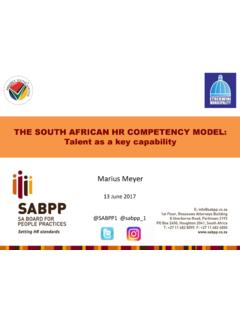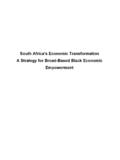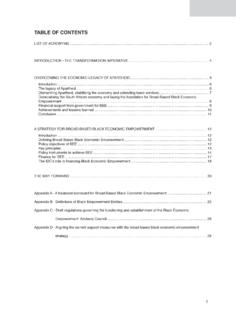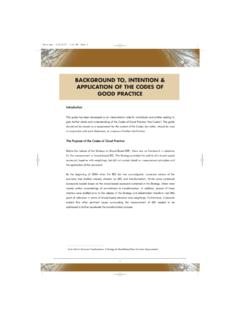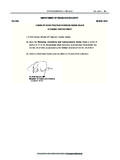Transcription of Women’s Economic Empowerment: Employment …
1 Women s Economic Empowerment: Employment equity and gender transformation in the workplace status , interventions and recommendations Commissioner Janine Hicks November 2015 CGE Mandate SA Constitution: S187 of the Constitution require the CGE to promote respect for, and the protection, development and attainment of gender equality CGE Act No 39 of 1996: The CGE mandate is to monitor and evaluate legislation, policies and practices of the state, statutory bodies and private businesses, as well as indigenous and customary laws and practices; research and make recommendations to Parliament; receive and investigate complaints of gender discrimination; and conduct public awareness and education on gender equality. CGE has powers of subpoena and litigation. PEPUDA Act 4 of 2000: Obligates the CGE to institute proceedings of unfair discrimination on the grounds of gender Vision: The CGE vision is a society free from gender oppression and all forms of inequality Globally: transformation for development Women s empowerment and eradication of gender inequalities as cornerstone to development.
2 No growth in the absence of equity . Global gender Gap report (2014) cites direct correlation between gender equality and GDP per capita, and World Bank Report (2014) calls for innovative measures to level the playing field and unleash women s Economic potential World Economic Forum Global gender Gap Report (2014) cites gender gap for women s Economic participation at 60% - noting it will take 81 years for gender parity in the work place Studies indicating value of women in leadership in contributing to increased corporate sustainability and Economic growth in terms of harnessing women s Economic potential and contribution, positive impact of fostering diversity in the workplace , and impact on organisational effectiveness and performance Growing acceptance of quota systems to legislate minimum representation of women on boards (30-40% in India, Germany, Malaysia, Ital, Netherlands, Denmark, Japan et al) Constitutional and International Framework Constitution bans discrimination on the basis of race, gender , sex.
3 Sexual orientation, age, ILO Convention (No. 111 ratified 2000) concerning Equal Remuneration for Men and Women Workers for Work of Equal Value Art 2 requires member states to promote and ensure the application to all workers of the principle of equal remuneration for men and women workers for work of equal value, by means of national laws, recognised machinery for wage determination, and collective agreements. ILO Convention (No. 100 ratified 1997) concerning Discrimination in Respect of Employment Occupation including access to vocational training and Employment requires member states to pursue national policy to promote equality of opportunity and treatment in respect of Employment and occupation, with a view to eliminating any discrimination. National Legislative Framework Domestication and implementation of Constitutional and ILO conventions have seen the development of the following key labour legislation: Broad Based Black Economic Empowerment Act (2003) Employment equity Act (1998) Labour Relations Act (1996) BCEA (1997) Skills Development Act (1998) PEPUDA (2000) Key Provisions.
4 EE Act Provides action plans for transformation , and guidelines for building capacity in the workplace , including women s representation transformation as an imperative that should cascade to all levels in the organisation Recruitment, training and development, promotion and remuneration policies to be aligned with transformation and empowerment, at all levels Affirmative action measures designed to ensure suitably qualified persons from designated groups have equal Employment opportunities across all occupational levels Creation of a larger pool of suitably qualified people from designated groups through training and development strategies, and review of policies to identify barriers to their entry, advancement, promotion and retention in the workplace transformation statistics 2015 (BWASA) Women comprise of the population in South Africa, and of the employed population Women constitute of SOE top management, and of senior management positions within the public service (women constitute 58% of public service overall getting in, but not ahead ) Women constitute of Executive Manager positions (the slowest growth), and of Directors of JSE-listed companies and SOEs, in mostly non-executive directorship positions (only of executive directors) Women constitute of leadership of entities, comprising of Chairpersons of Boards, and of CEOs (decrease from 2010) gender wage gap persists.
5 Women earn 24% less than their male counterparts (now outlawed in EE Act as unfair discrimination) At all levels in the workplace , women remain significantly under-represented, and excluded from key decision-making positions Women s representation within private sector remains the lowest At the current pace of transformation , SA will take 2-3 decades before gender parity is reached CGE gender transformation interventions gender transformation in the workplace investigation, hearings and reporting since 2009 Series of national and provincial hearings convened with government DGs, CEOs of companies and Municipal Managers, to hold them to account for slow pace of gender transformation in the workplace , and inadequate promotion of women with disabilities. Hearing purpose: - Consider impact of Employment equity measures on women, and women with disabilities. - Establish measures put in place to comply with Employment equity requirements relating to gender and disability.
6 - Identify challenges and progress experienced; best practice. - Raise awareness on relevant international commitments and national legislation Findings: private sector gender and disability components of Employment equity seem to be largely unknown/ignored, in contravention of the Employment equity Act. Companies demonstrate lack of commitment to gender transformation , lacking coherent gender transformation policy, and policy addressing disability little evidence of targets, strategy, targeted skills development programmes, designated responsibility measured through performance management mechanisms. transformation appears to be favouring white women - insufficient measures taken to recruit and promote black women to positions of senior and executive management. Sexual harassment policies not put in place in some companies, in contravention of BCEA and LRA. Poor representation of women in mining and engineering sectors need for innovative interventions to encourage and support women Companies cited difficulties in recruiting people with disabilities - need for clear targets and strategies.
7 Findings: Public sector Departments ongoing failure to address transformation viz gender and disability, and meet state target for women s representation at senior management levels (50%), and Employment of persons with disabilities (2%), although faring better than the private sector. DPSA claims departments are generally failing to report adequately on Employment equity - lack of accountability and consequences Issues relating to transformation , gender equality, Employment equity and gender mainstreaming are categorized as human resource and corporate services issues No clear budget allocation for gender transformation ; no supportive policies viz flexi-time/child-care/working from home; sexual harassment policy inadequate. Many departments coincided gender and disability sets of issues, rather than recognizing these as requiring individual attention. Scarce skills in technical, finance and science sectors impacting on appointment of women.
8 Findings: EThekwini Municipality (2011/12) Failing to comply with EE ito race, gender and disability, despite EE plan and inclusion of transformation as KPA for all senior manager Women comprise 20% of senior and top management five year target of 30% set, yet EThekwini continues to recruit men EThekwini has far too many policies that are still in draft EThekwini is still struggling with technical workplace forums and seems to be experiencing problems here. Availability of applicants from designated groups, especially females in engineering and Built Environment - development programmes implemented capacity-building; scholarships; scarce skills interventions in engineering sector with tertiary institutions. Under DG review for EE awaiting outcome of findings Pockets of resistance to EE still exist Male versus female salary disparities exist Greater international exposure required for female employees PWD recruitment slow Update.
9 Ethekwini Municipality (2013/14) PWD Committee in place Employment equity is now on the scorecard 2014-2018 EE Plan in place and adopted, to be implemented Mentorship and Coaching programmes in place, including a pilot Female Development Programme, and a Women s Forum Female participants in Learnerships increased Female participants in work experience increased Strategic approach required to increase number of females in Engineering Strategic drive is required for people with disabilities Change management sessions were recommended More females to be included in international assignments Implement equal pay for work of equal value to address discrepancies Follow up Department of Labour outcome EE hearing findings: Best practice Some proactive interventions to increase the scarce skills pool, through bursaries, coaching, learnership programmes and leadership development Executive training and mentorship programmes for women employees; incl career-pathing and succession planning; women s forums Some entities have set Employment equity targets, ring-fenced posts; assigned responsibility for EE at a senior level, integrated these in strategic plans, with monitoring interventions put in place, and assigned responsibility for transformation , including this in performance evaluation processes.
10 Several departments initiated gender equality awareness-raising within the workplace ; inclusion of gender and diversity in leadership programmes. Some companies introduced flexible working environment hours/home. Tertiary institution reports KPA for transformation incl in executive members job descriptions; PWD learnership programme and absorption of graduates into staffing structures; deviation of appointments from EE targets requires written authority, with M&E system in place to assess; childcare and flexible working hours introduced; support for female academics to finalise studies transformation strategies that work (BWASA) work-life balance: Acknowledge domestic/child care burden, and pressure to manage both motherhood and career. Virtual office/technology and flexible working hours can improve productivity and enable women to balance these demands a supportive culture: Emphasis performance and quantifiable outputs, encouraging motivation and teamwork, through appropriate policies and retain the right people: Ensure leadership comprises suitably qualified women, using mentorship programmes, training and recruitment strategies to bring women into senior management.




